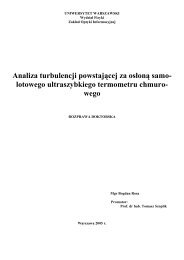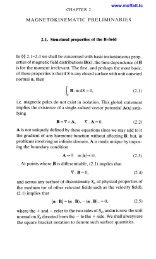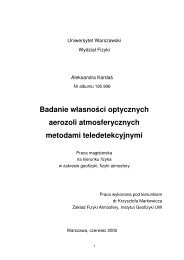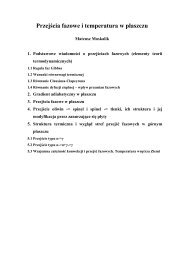An example of development of singularity in a solution to the force ...
An example of development of singularity in a solution to the force ...
An example of development of singularity in a solution to the force ...
Create successful ePaper yourself
Turn your PDF publications into a flip-book with our unique Google optimized e-Paper software.
<strong>An</strong> <strong>example</strong> <strong>of</strong> <strong>development</strong> <strong>of</strong> <strong>s<strong>in</strong>gularity</strong><br />
<strong>in</strong> a <strong>solution</strong> <strong>to</strong> <strong>the</strong> <strong>force</strong>-free Euler equation<br />
Olga Podvig<strong>in</strong>a<br />
olgap@mitp.ru<br />
Vladislav Zheligovsky<br />
vlad@mitp.ru<br />
International Institute <strong>of</strong> Earthquake Prediction Theory<br />
and Ma<strong>the</strong>matical Geophysics,<br />
79 bldg. 2, Warshavskoe ave., 113556 Moscow, Russian Federation<br />
Labora<strong>to</strong>ry <strong>of</strong> general aerodynamics, Institute <strong>of</strong> Mechanics,<br />
Lomonosov Moscow State University,<br />
1, Michur<strong>in</strong>sky ave., 119899 Moscow, Russian Federation<br />
A mixed Euler-Lagrangian description <strong>of</strong> vortex l<strong>in</strong>e transport by a <strong>force</strong>-free<br />
non-viscous fluid flow was recently proposed by Kuznetsov & Ruban [1]. The motion<br />
<strong>of</strong> Lagrangian markers R(a, t) satisfies<br />
∂R<br />
∂t<br />
= v(R, t) −<br />
Ω(R, t) · v(R, t)<br />
|Ω(R, t)| 2 Ω(R, t). (1)<br />
Here a is <strong>the</strong> <strong>in</strong>itial position <strong>of</strong> a marker: R(a, 0) = a, t is time, v is <strong>the</strong> flow<br />
velocity, and<br />
Ω(R, t) ≡ curl R v(R, t) (2)<br />
is vorticity. Equations (1) and (2) are closed by <strong>the</strong> relation<br />
Ω(R(a, t), t) =<br />
(<br />
det ‖ ∂R<br />
∂a ‖ ) −1<br />
(Ω 0 · ∇ a )R(a, t), (3)<br />
where Ω(a, 0) = Ω 0 (a) is <strong>the</strong> <strong>in</strong>itial vorticity.<br />
We have developed a code for numerical <strong>solution</strong> <strong>of</strong> <strong>the</strong> system (1)-(3). 2π-periodicity<br />
<strong>in</strong> space is assumed, so that Fast Fourier Transforms can be used for <strong>the</strong><br />
<strong>in</strong>version <strong>of</strong> curl <strong>in</strong> (2). A second-order Adams-Bashforth f<strong>in</strong>ite-difference scheme is<br />
used for numeric <strong>in</strong>tegration <strong>of</strong> (1). To test <strong>the</strong> code, we have checked that an ABC<br />
flow, which is a steady <strong>solution</strong> <strong>to</strong> <strong>the</strong> <strong>force</strong>-free Euler equation, <strong>in</strong> computations<br />
rema<strong>in</strong>s unaltered. We have also verified that <strong>the</strong> numerical error <strong>in</strong> conservation<br />
<strong>of</strong> <strong>the</strong> <strong>to</strong>tal k<strong>in</strong>etic energy <strong>of</strong> <strong>the</strong> flow is O(h 2 ) (here h is <strong>the</strong> size <strong>of</strong> <strong>the</strong> a-mesh,<br />
where Ω 0 is set); this is consistent with <strong>the</strong> order <strong>of</strong> methods applied for spatial<br />
discretization <strong>of</strong> <strong>the</strong> problem (2) and with f<strong>in</strong>ite-difference schemes used <strong>to</strong> evaluate<br />
gradients <strong>in</strong> (3).<br />
1
Computations have been performed with a uniform mesh <strong>of</strong> 128 3 po<strong>in</strong>ts. Collapse<br />
is found <strong>to</strong> develop <strong>in</strong> a flow, which is <strong>in</strong>itially chosen <strong>to</strong> have random Fourier<br />
harmonics and an exponentially decay<strong>in</strong>g energy spectrum. The flow does not possess<br />
any symmetry. Accord<strong>in</strong>g <strong>to</strong> <strong>the</strong> <strong>the</strong>ory <strong>of</strong> Kuznetsov & Ruban [2], <strong>in</strong> <strong>the</strong><br />
region <strong>of</strong> collapse vorticity behaves as (t 0 − t) −1 , which is <strong>in</strong>deed found <strong>in</strong> computations<br />
(see Fig.1). Their ano<strong>the</strong>r prediction is confirmed: eigenvalues <strong>of</strong> <strong>the</strong> Hessian<br />
‖<br />
∂ 2<br />
∂a i ∂a j<br />
|Ω| −1 ‖ at <strong>the</strong> po<strong>in</strong>t <strong>of</strong> <strong>s<strong>in</strong>gularity</strong> are non-s<strong>in</strong>gular and slightly depend on<br />
time.<br />
Figure 1: |Ω| −1 (vertical axis) as a function <strong>of</strong> time (horizontal axis).<br />
References<br />
[1] Kuznetsov E.A. & Ruban V.P. (2000). Hamil<strong>to</strong>nian dynamics <strong>of</strong> vortex and<br />
magnetic l<strong>in</strong>es <strong>in</strong> hydrodynamic type systems. Phys. Rev. E, 61, 831–841.<br />
[2] Kuznetsov E.A. & Ruban V.P. (2001). Break<strong>in</strong>g <strong>of</strong> vortex l<strong>in</strong>es – a new mechanism<br />
<strong>of</strong> collapse <strong>in</strong> hydrodynamics. Submitted.<br />
2


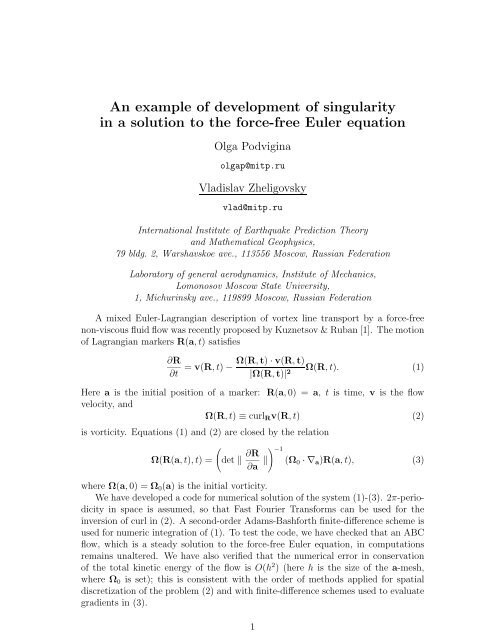


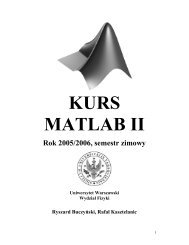
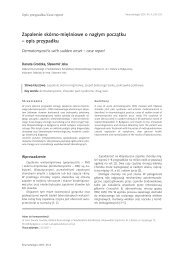
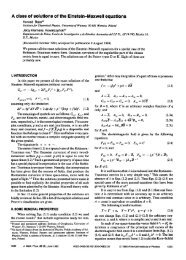
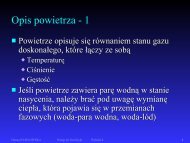
![slajdy [PDF, 0,6 MiB] - Instytut Geofizyki](https://img.yumpu.com/22546539/1/190x143/slajdy-pdf-06-mib-instytut-geofizyki.jpg?quality=85)
